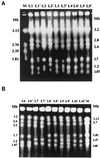Oral colonization, phenotypic, and genotypic profiles of Candida species in irradiated, dentate, xerostomic nasopharyngeal carcinoma survivors
- PMID: 10834980
- PMCID: PMC86768
- DOI: 10.1128/JCM.38.6.2219-2226.2000
Oral colonization, phenotypic, and genotypic profiles of Candida species in irradiated, dentate, xerostomic nasopharyngeal carcinoma survivors
Abstract
The aim of this study was to investigate oral yeast colonization and oral yeast strain diversity in irradiated (head and neck), dentate, xerostomic individuals. Subjects were recruited from a nasopharyngeal carcinoma clinic and were segregated into group A (age, <60 years [n = 25; average age +/- standard deviation (SD), 48 +/- 6 years; average postirradiation time +/- SD, 5 +/- 5 years]) and group B (age, >/=60 years [n = 8; average age +/- SD, 67 +/- 4 years; average postirradiation time +/- SD, 2 +/- 2 years]) and were compared with age- and sex-matched healthy individuals in group C (age, <60 years [n = 20; average age +/- SD, 44 +/- 12 years] and group D (age, >/=60 years [n = 10; average age, 70 +/- 3 years]). Selective culture of oral rinse samples was carried out to isolate, quantify, and speciate yeast recovery. All test subjects underwent a 3-month comprehensive oral and preventive care regimen plus topical antifungal therapy, if indicated. A total of 12 subjects from group A and 5 subjects from group B were recalled for reassessment of yeast colonization. Sequential (pre- and posttherapy) Candida isolate pairs from patients were phenotypically (all isolate pairs; biotyping and resistotyping profiles) and genotypically (Candida albicans isolate pairs only; electrophoretic karyotyping by pulsed-field gel electrophoresis, restriction fragment length polymorphism [RFLP], and randomly amplified polymorphic DNA [RAPD] assays) evaluated. All isolates were Candida species. Irradiated individuals were found to have a significantly increased yeast carriage compared with the controls. The isolation rate of Candida posttherapy remained unchanged. A total of 9 of the 12 subjects in group A and 3 of the 5 subjects in group B harbored the same C. albicans or Candida tropicalis phenotype at recall. Varying degrees of congruence in the molecular profiles were observed when these sequential isolate pairs of C. albicans were analyzed by RFLP and RAPD assays. Variations in the genotype were complementary to those in the phenotypic characteristics for some isolates. In conclusion, irradiation-induced xerostomia seems to favor intraoral colonization of Candida species, particularly C. albicans, which appeared to undergo temporal modifications in clonal profiles both phenotypically and genotypically following hygienic and preventive oral care which included topical antifungal therapy, if indicated. We postulate that the observed ability of Candida species to undergo genetic and phenotypic adaptation could strategically enhance its survival in the human oral cavity, particularly when salivary defenses are impaired.
Figures



References
-
- Anaissie E J. Opportunistic mycoses in the immunocompromised host: experience at a cancer centre and review. Clin Infect Dis. 1992;14(Suppl. 1):S43–S53. - PubMed
-
- Bostock A, Khattak M N, Matthews R, Burnie J. Comparison of PCR fingerprinting, by random amplification of polymorphic DNA, with other molecular typing methods for Candida albicans. J Gen Microbiol. 1993;139:2179–2184. - PubMed
-
- Brown L R, Dreizen S, Daly T E, Drane J B, Handler S, Riggan L J, Johnston D A. Interrelations of oral microorganisms, immunoglobulins, and dental caries following radiotherapy. J Dent Res. 1978;57:882–893. - PubMed
Publication types
MeSH terms
LinkOut - more resources
Full Text Sources
Medical

